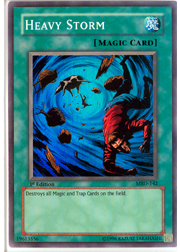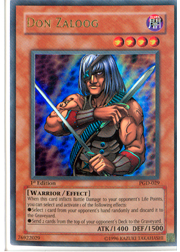Legends from the Battlefields: The Pro Storm
Welcome duelists to my newest column here on Metagame.com. It’s my pleasure to inform you that I will be writing a bi-weekly piece for competitive and up-and-coming players alike. You’ve seen how I break down some of the best decks in competitive play in The Champions, but now you’ll get to hear from me about some of the best in-game plays that have ever been made. I’ll be taking plays from feature matches found right here on Metagame.com, some more widely known stories and so-called myths, and plays drawn from my own experiences and eyewitness accounts.
 I’m going to start things off with a play that has come to be known as the "Pro Storm." The Pro Storm is any play that involves getting multiple cards from your opponent using Heavy Storm and a series of plays that forces your opponent to commit extra cards to the field. The Pro Storm got its name simply because it was originally used by only the best players. The first way it was done was by setting Heavy Storm in the spell and trap zone. When Harpie’s Feather Duster was Forbidden, people often thought they were safe to set as many as one more card than the opponent had set in his or her spell and trap zone.
I’m going to start things off with a play that has come to be known as the "Pro Storm." The Pro Storm is any play that involves getting multiple cards from your opponent using Heavy Storm and a series of plays that forces your opponent to commit extra cards to the field. The Pro Storm got its name simply because it was originally used by only the best players. The first way it was done was by setting Heavy Storm in the spell and trap zone. When Harpie’s Feather Duster was Forbidden, people often thought they were safe to set as many as one more card than the opponent had set in his or her spell and trap zone.
This meant that if I had one spell or trap set face down, you could feel safe setting two. When the masses began to emulate this style of play, some of the best players quickly saw an opening. By setting Heavy Storm as the one card face down, I could fool my opponent into setting two cards to the back row. From the opponent’s point of view, he or she had two set spell or trap cards and I had one. A Heavy Storm would mean me losing my spell or trap card and the Storm to the opponent’s two cards, resulting in an even trade: as long as the Storm wasn’t the set card.
Setting two cards also provides safety against an end-phase Dust Tornado or Mystical Space Typhoon. Since Sakuretsu Armor, Bottomless Trap Hole, Berserk Gorilla, and other big monsters were at an all-time high during the period in which this play was first popularized, protecting yourself from the battle phase using your trap cards was very important. Protecting against end phase spell and trap removal was therefore a top priority. If your opponent was able to break your back row, he or she could capitalize big time on the battle phase: forcing players to commit more than one card to the spell and trap zone.
That is, of course, what made the play so safe and so devastatingly effective. Not only could you claim a pair of un-chainable defensive cards, but during the battle phase you were free to wreak the very same havoc that your opponent over-committed in order to prevent. Such a series of plays could leave your opponent with half the amount of defensive cards and monsters he or she had before, with you losing nothing but Heavy Storm. You would be in a strong position to win the game.
As time went on, the Pro Storm became less and less effective: players became increasingly aware of the tactic. Breaker the Magical Warrior was played early and broke a lot of Heavy Storm cards, and many players would throw down their copies of Mystical Space Typhoon before setting cards to their back rows. Destroying Heavy Storm meant that you were free to commit as many cards as you felt necessary to ensure the battle phase never broke you again. Players began to realize the risk of setting Heavy Storm against other experienced players.
It was during this time that the Pro Storm was most effective. The first Shonen Jump Championship in Chicago all the way back in 2005 showcased Dale Bellido, who, at the time, abused the Pro Storm as often as he could. In his feature match with Carlos Santiago in the finals, setting up the Pro Storm was the first play Dale made, and it put him in a position to win. If Dale hadn’t used a Pro Storm, the match would have been relatively even. Carlos would have likely only set one card to his spell or trap zone or Dale would have had to sacrifice a trap card to get the two Carlos would set.
 We see in the feature match that after a flurry of turns, Carlos was left with nothing to Dale’s pair of face-down spell or trap cards. Dale was eventually able to pull out the win by summoning Don Zaloog via Premature Burial and normal summoning another monster: eventually destroying Carlos’s Sangan and discarding the monster Sangan searched out. Had Carlos only lost one of his trap cards to the Heavy Storm, he would have been able to deal with one of the two attackers, leaving Zaloog unable to force a discard.
We see in the feature match that after a flurry of turns, Carlos was left with nothing to Dale’s pair of face-down spell or trap cards. Dale was eventually able to pull out the win by summoning Don Zaloog via Premature Burial and normal summoning another monster: eventually destroying Carlos’s Sangan and discarding the monster Sangan searched out. Had Carlos only lost one of his trap cards to the Heavy Storm, he would have been able to deal with one of the two attackers, leaving Zaloog unable to force a discard.
Over the course of the game the Pro Storm actually cost Carlos three cards (the two he lost to the Storm and the resultant loss of the Sangan search). You might say that Dale won because of the Pro Storm: without it, we know Carlos could have evened things up later on. Dale also used the move during both games against Paul Levitin just prior to the match with Carlos. There’s no doubt in my mind that, without the Pro Storm, Dale probably would not have won the tournament. The decks our team played simply weren’t as good as the other decks that had made the Top 8.
If you never thought before that the first card you set could win you a Shonen Jump Championship, you’d better believe it now. The Pro Storm has never really gone away. Rather, it’s been modified to make it a less risky play. In the next edition of this column I will break down how the play has evolved, with specific examples from Jerry Wang and myself in featured match play.